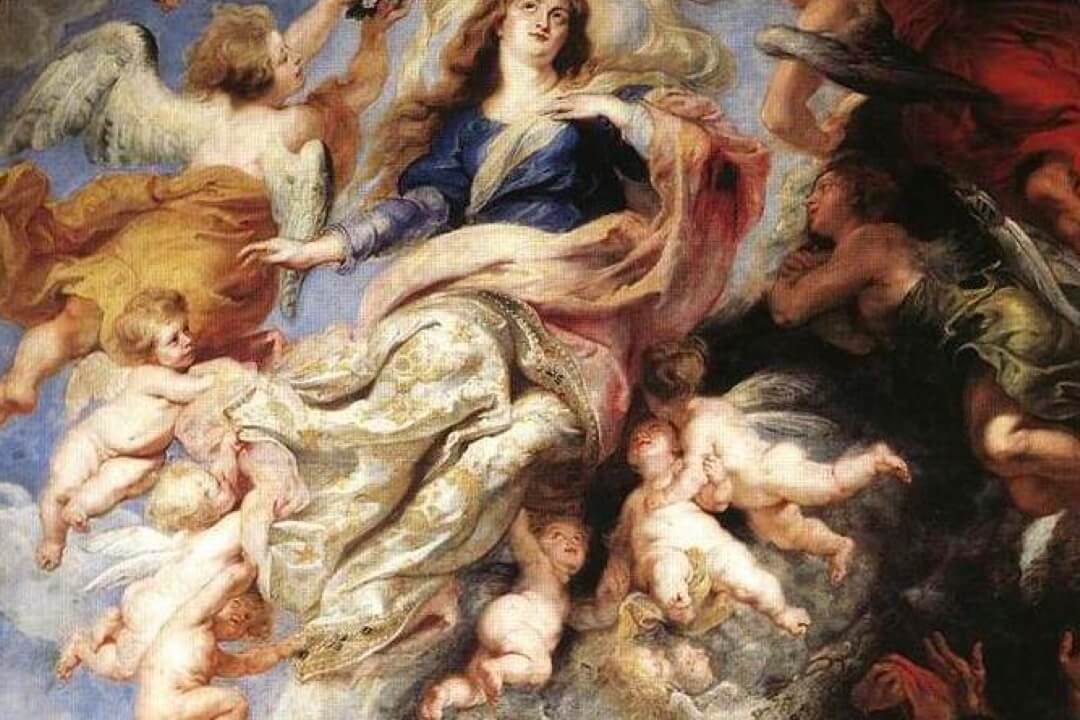Alias
The Assumption,Falling Asleep of the Blessed Virgin Mary
Introduction
The Assumption of Mary is one of the four Marian dogmas of the Catholic Church. (The word 'assumption' derives from the Latin word assūmptiō meaning "taking up"). Pope Pius XII defined it in 1950 in his apostolic constitution Munificentissimus Deus as follows:
We proclaim and define it to be a dogma revealed by God that the immaculate Mother of God, Mary ever virgin, when the course of her earthly life was finished, was taken up body and soul into the glory of heaven.
The declaration was built upon the 1854 dogma of the Immaculate Conception of Mary, which declared that Mary was conceived free from original sin, and both have their foundation in the concept of Mary as the Mother of God. It leaves open the question of whether Mary died or whether she was raised to eternal life without bodily death.
The equivalent belief (but not held as dogma) in the Eastern Orthodox Church is the Dormition of the Mother of God or the "Falling Asleep of the Mother of God".
History
The first known narrative to address the end of Mary's life is the apocryphal third- and possibly second-century, Liber Requiei Mariae ("Book of Mary's Repose"). According to Stephen J. Shoemaker,
this earliest evidence for the veneration of Mary appears to come from a markedly heterodox theological milieu ... [suggesting] that the cult of the Virgin had its origins somewhere outside of the proto-orthodox stream of early Christianity
The next oldest surviving text outside the New Testament relevant to the development of the Marian tradition is the "Six Books Dormition Apocryphon", associated with the Collyridians who were condemned by Epiphanius of Salamis "for their excessive devotion to the Virgin Mary". Again, Shoemaker:
Even though ... there is absolutely nothing at all heterodox about the Six Books Dormition Apocryphon, or seemingly even the related group [the Chollyridians, ... Epiphanius's] condemnation of Marian piety as theologically transgressive and subversive also suggests some intriguing possibilities regarding an "extra-orthodox" origin for Marian veneration.
The earliest Dormition traditions all see Mary's death as special. Eamon Duffy argues that there is no historical evidence for Mary's assumption, and though the state of the sources concerning the Dormition and the Assumption is limited, it is generally agreed that it was unknown in the earliest ages of the Church, though, many scholars now accept that the Dormition and Assumption traditions can be traced to as early as the 2nd century, with Shoemaker stating,
Other scholars have similarly identified these two apocrypha as particularly early. For instance, Baldi, Masconi, and Cothenet analyzed the corpus of Dormition narratives using a rather different approach, governed primarily by language tradition rather than literary relations, and yet all agree that the Obsequies (i.e., the Liber Requiei) and the Six Books apocryphon reflect the earliest traditions, locating their origins in the second or third century.
Scholars of the Studium Biblicum Franciscanum "argued that during or shortly after the apostolic age a group of Jewish Christians in Jerusalem preserved an oral tradition about the end of the Virgin’s life." Thus, by pointing to oral tradition, they argued for the historicity of the Assumption and Dormition narratives. "The ancient narratives are neither clear nor unanimous in either supporting or contradicting the modern dogma" of the assumption. The New Testament is silent regarding the end of her life, the early Christians produced no accounts of her death, and in the late 4th century Epiphanius of Salamis wrote he could find no authorized tradition about how her life ended. Nevertheless, although Epiphanius could not decide on the basis of biblical or church tradition whether Mary had died or remained immortal, his indecisive reflections suggest that some difference of opinion on the matter had already arisen in his time, and he identified three beliefs concerning her end: that she died a normal and peaceful death; that she died a martyr; and that she did not die. Even more, in another text Epiphanius stated that Mary was like Elijah because she never died but was assumed like him.
Gradually did these practices became more accepted among the proto-orthodox Christians during the course of the fourth century. Notable later apocrypha based on these two texts include De Obitu S. Dominae and De Transitu Virginis, both probably from the 5th century, with further versions by Dionysius the Areopagite, and Gregory of Tours, among others. The Transitus Mariae was among apocrypha condemned in a 6th-century work called Decretum Gelasianum, but by the early 8th century the belief was so well established that John of Damascus could set out what had become the standard Eastern tradition, that "Mary died in the presence of the Apostles, but that her tomb, when opened, upon the request of St Thomas, was found empty; wherefrom the Apostles concluded that the body was taken up to heaven."
The Feast of the Dormition, imported from the East, arrived in the West in the early 7th century, its name changing to Assumption in some 9th century liturgical calendars. In the same century Pope Leo IV (reigned 847-855) gave the feast a vigil and an octave to solemnise it above all others, and Pope Nicholas I (858-867) placed it on a par with Christmas and Easter, tantamount to declaring Mary's translation to Heaven as important as the Incarnation and Resurrection of Christ. In the 10th century the German nun Elisabeth of Schonau was granted visions of Mary and her son which had a profound influence on the Western Church's tradition that Mary had ascended body and soul into Heaven, and Pope Benedict XIV (1740-1758) declared it "a probable opinion, which to deny were impious and blasphemous".
Date
August 15
Sunday nearest to August 15

